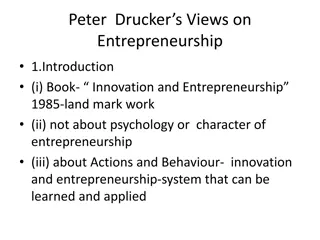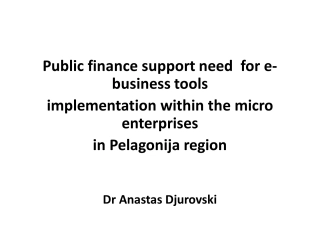Understanding Social Entrepreneurship and Social Enterprises
Social entrepreneurship involves individuals known as social entrepreneurs who focus on addressing social, cultural, or environmental issues without the sole aim of making profits. These enterprises operate with the goal of creating a social impact rather than prioritizing financial gain. Social enterprises, which are not for personal profit, derive a significant portion of their income from trading and aim to benefit stakeholders and society as a whole.
Download Presentation

Please find below an Image/Link to download the presentation.
The content on the website is provided AS IS for your information and personal use only. It may not be sold, licensed, or shared on other websites without obtaining consent from the author. Download presentation by click this link. If you encounter any issues during the download, it is possible that the publisher has removed the file from their server.
E N D
Presentation Transcript
Module: Social entrepreneurship and social enterprises (including green entrepreneurship)
Social entrepreneurship A brief introduction.
Entrepreneurship is the process of: designing launching and running a new business, which is often initially a small business.
Which people are called entrepreneurs? People willing to take a risk in order to make a profit. Such businesses aim mainly at solving issues in the industry and service areas.
Social entrepreneurship is a similar process, run by people called social entrepreneurs, who aim at solving social, cultural, or environmental issues, often without the need to make profit. The ultimate goal of an entrepreneur is to create economic wealth, while the ultimate goal of the social entrepreneurs is to fulfill their social mission.
What is a social enterprise? Stakeholders A group or individual affected by the activities of the business Social enterprises are not for personal profit enterprises that derive a minimum of 25% to 50% of their income from trading.
A social enterprise is an operator in the social economy whose main objective is to have a social impact rather than make a profit for their owners or shareholders. It operates by providing goods and services for the market in an entrepreneurial and innovative fashion and uses its profits primarily to achieve social objectives. It is managed in an open and responsible manner and, in particular, involve employees, consumers and affected by its activities . 2011 European Commission organizational definition included in the Social Business Initiative (SBI): stakeholders commercial
The social dimension Accordingly, there are three dimensions for an ideal model of social enterprise: The The governance dimension entrepreneuria l dimension
Impact: Healthcare: building new hospitals, health clinics with cheaper services, educating the patients in order to reduce various illnesses. Education: decrease drop-out rates, build infrastructure, provide study materials, train teachers, advise students on their career path. Human rights: improve liberty, pursuit of happiness, fight discrimination, promote freedom of speech and equality. Culture, to promote social transformation and community integration. Environment: sustainable products and services, waste disposal management, emissions reduction, preserving land and wildlife. Health care Culture Education Environmen t Human rights
Green entrepreneurship! Addressing an environmental problem or need through a financially sustainable business plan, has a positive impact on the environment, community, and economy.
A social enterprise operates as a business. Surplus money from the business is reinvested in the business or community. What do we mean by shareholders? A social enterprise is not driven to maximize profits for shareholders. If you have decided to run your Social Enterprise for-profit, using a private company structure, this structure has shareholders and investors with shares that are privately held and traded as opposed to holding shares in a public company where they can be traded on the stock exchange. These shareholders will receive a distribution of the profit, and the remaining profit will be reinvested into the Social Enterprise. A social enterprise is not a charity. The importance of entrepreneurship has not been fully acknowledged by academia.
Business models: Non-profit: the surplus of its financial and other resources responds to the social needs rather than pay returns to its shareholders. Such companies do not pay taxes. Non-profit For profit: businesses, they pay taxes. They operate in areas where it is difficult to find loans and financing for social needs. Philanthro- preneurship For profit Hybrid non-profit is willing to use profit from some activities to sustain its other operations which have a social or community purpose. Philanthropreneurship: invest some of their profits for solving social, cultural or environmental issues. corporations which Hybrid
Attributes that make a good social entrepreneur: The need for achievement and a high- tolerance for ambiguity. Willingness to bear risk and self-efficacy. Internal locus of control.
Problem solving: Preparation Incubation Insight Evaluation Elaboration
Why is entrepreneurship education important? a. Promotes enterprising skills b. Assists with the transition from education to work
Statistics Category Percentage Women-led businesses in the world 33% Ethnic minorities SMES in the UK (2014) 367,000
Steps for creating a social enterprise: 1. Identify a problem offer a solution. 2. Decide on your social mission identify your product. 3. Gather a team. 4. Figure your initial financing. 5. Work within a legal framework what is the framework in your country? 6. What is your business plan? 7. Be visible. 8. Measure your impact.
Thank you for your attention ! Work on the activities and the exercises that follow, to test your knowledge.

















































